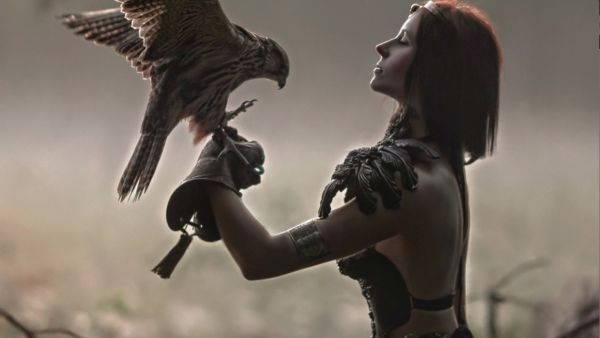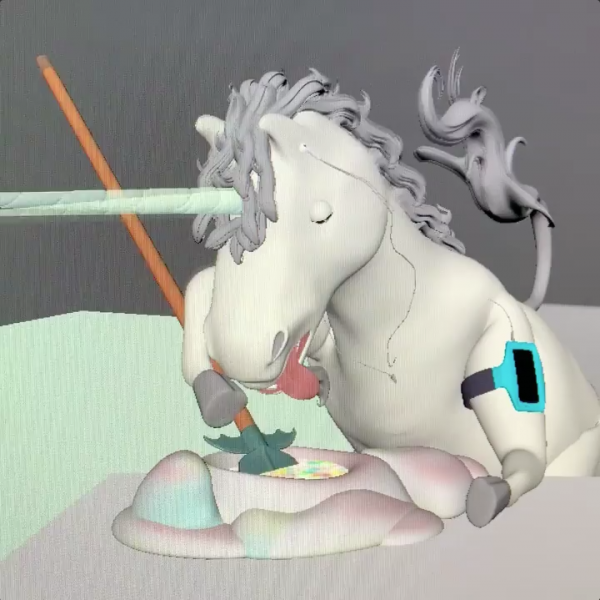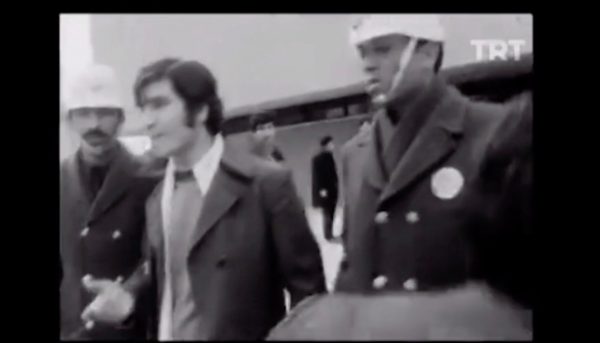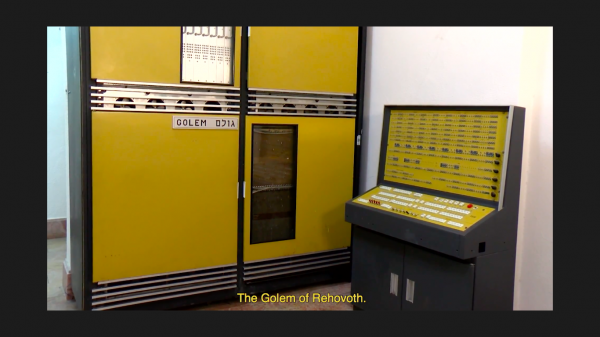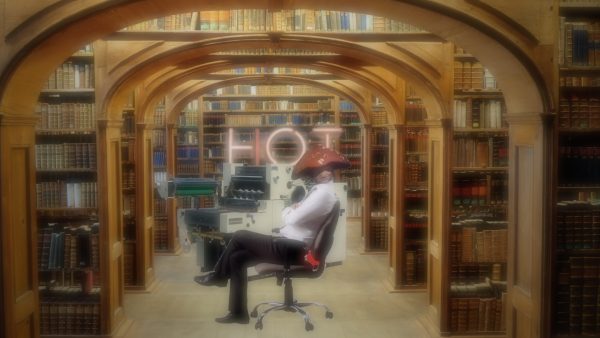Hoard Inaugural
Hoard Inaugural Program PDF, 2019
Hoard Inaugural Sept. 6 – Oct. 12, 2019, Los Angeles Contemporary Archive
Anonymous, Autonomous Oral History Group, Kelman Duran, Arshia Haq, Nick Kochornswasdi, Halldora Miyoko Magnusdottir, Olivia Mole, Misael Oquendo, Rapterotica/Cephalerotica Index, Hande Sever, Alan Tofighi, Adam Wand, organized by Scott Benzel
Video
Rapterotica/Cephalerotica Index, selections from the database, ongoing/2019 4 min.
Misael Oquendo, Ladrón, 2019 7 min.
Nick Kochornswasdi, Please Come Over, 2015, videogame, as played by Markplier 10 min. Started Walking), 2018 7 min.
Autonomous Oral History Group, Interviews and Music Textures: Judge Steven Z. Perren, Batyah Mayer, and Consuelo Xiques, 2019 6 min. total
Anonymous, Selections from the ‘Get Syked’ Archive by Former Employees, 2019 11 min.
Halldora Magnusdottir, Serendipity Pattern of Geomyths, V. Metaform, 9 min. 30 sec.
Arshia Haq, Use By ۸۷ (Use by 87) 18 min.
Adam Wand, The Golem of Yehovoth, 2019 10 min.
Kelman Duran, Archive 264, 2019 4 min.
Olivia Mole, interstitial videos throughout, 2019
VR
Olivia Mole, Bambi Holes, vr, 2019
Alan S. Tofighi, TPLRDR Stereographically Reprocessed I-VII, vr, 2018
Videogame
Nick Kochornswasdi, Please Come Over, 2015
Artist’s Book
Halldora Magnusdottir, Serendipity Pattern of Geomyths II, 2018
Hoard Inaugural is the ‘inauguration’ of a collection of works whose subjects or creators tread the line between the indexical, rationalized modality of the archive, the aestheticized art collection, and the ‘hoard’, a term that has become synonymous with irrationality and psychological dysfunction as manifested in material accumulation.
The standard cultural interpretation of hoarding roots it in dysfunction, in OCD and the legacy of Freudian anality as it collides with the material world. Hoarding is often regarded as a malady affecting the lower tiers of the class spectrum, however, when value judgments regarding specific materiality are removed, it bears remarkable similarity to some of culture’s most highly regarded activities. Activities such as the accumulation and preservation of artifacts in museums, libraries, and archives, and the acquisition of wealth or money above levels necessary for survival.
Photographs of the homes of Modernist collectors like the Arensbergs, or Gertrude Stein and Alice B. Toklas, or of Andre Breton’s atelier, or of Freud’s office, betray similarities to scenes on the television show Hoarders, with the important difference that the objects piled into the collectors’ spaces are considered ‘culturally significant’. This significance is very much a phenomenon of external cultural agreement; the value of a given collection or ‘hoard’ is based almost entirely on externalist considerations.
Social Psychologists Randy O. Frost And Rachel C. Gross’s landmark 1993 study The Hoarding Of Possessions was a detailed attempt to get beyond Freudian analysis and OCD and to address instead the psychocultural roots of the phenomenon. Frost and Gross cite Furby’s analysis as one sociocultural precursor: Furby concluded that central to the meaning of possession is control. Possessions are meaningful because people have use of them, or control over the use of them. People need to feel in control of their environment, and possessions allow them to do so.
Alan Tofighi’s TPLRDR Stereographically Reprocessed I VII incorporates seemingly polar extremes of the ontological axis – hoarding and VR – opposing the overactualized to the purely virtual. Tofighi’s photographic VR reproduction of an actual hoarder’s home suggests that the two phenomena are linked existentially and epistemically. The hoard which renders a home uninhabitable appears here tied to mounting terror around the crisis of homelessness which removes the body from the home entirely, exposing it to the ‘outside’, the violence of the street, and tying it to virtuality, the disappearance of ‘actual’ objects and enclosed space. Fullness and alienation, the fullness of terror in Freud’s ‘unheimlich’ (unhomely), and the ‘uncanny’ emptiness of VR are linked.
Hande Sever’s video works reveal the mechanisms of the index and collecting in the process of ‘othering’
political dissidents and immigrants, a methodology born in the 19th Century with the Hollerith tabulator, a punchcard based protocomputer for sorting populations. Günler Yürüdüğünde (As Days Started Walking) chronicles her mother’s experiences, told through vintage Turkish television footage and objects, following the aftermath of the 1980 Turkish coup d’état.
Olivia Mole’s VR and video work upsets cultural agreements on the values and meanings embodied by mainstays of popular and children’s culture. Across a wider project, Mole reinvents the figures of Bambi and the medieval unicorn as cultural fugitives who have rejected the work of cuteness and availability. Bambi Holes presents a Bambi unmoved by a barrage of casting agent pitches, in a state of emotional inertia brought on by an excess of manipulation.
Misael Oquendo’s video Ladrón vertiginously accumulates AI and CGI imagery, obscure subcultures, and peculiar narratives, piling a story about a family’s multigenerational oyster addiction onto a narrative about an archive of samizdat maintained by a ‘master’ incel. The result is something like a hallucination of the contemporary through the skewed lenses of Reddit and 4chan, the fog of Youtube and Gab aesthetics, and outrageous but weirdly personal narratives.
Halldora Magnusdottir’s ongoing Serendipity Pattern of Geomyths traces the global spread of myth. In collections of artifacts, artist’s books, and videos documenting her online and IRL explorations mapping tangled subterranean connections, she links disparate contemporary sites of myth to ancient global roots.
In Use By ۸۷ (Use by 87), Arshia Haq memorializes the television and advertising culture of the SWANA region (a region that she reimagines in her ongoing project Discostan) from the period of her youth, to create a catalog of personal and cultural ‘expired’ desires.
Kabbalah scholar and Walter Benjamin associate Gershom Scholem’s speech at the inauguration of the Golem Aleph, the first Israeli supercomputer, linked the retributive folk legend of the Golem and the alphanumerical mysteries of Kabbalah to the birth of technoscience. Adam Wand’s video The Golem of Rehovoth integrates Scholem’s speech, ephemera and publicity related to the unveiling of the supercomputer, and scenes from the early 20th Century Golem film subgenre.
Works by Kelman Duran, the Autonomous Oral History Group, and Nick Kochornswasdi raise questions of presentation, distribution, and facticity. Each incorporates the aesthetic and distributive elements of ‘entertainment’ to deliver information and data most often reserved for the sociological database or the activist meeting. Duran’s underground dance music and videos incorporate documentary sound and footage from the Dakota Water Protectors and other contemporary indigenous protection and liberation movements, bringing these movements into conversation with international youth culture. The Autonomous Oral History Group counterveils diverse individual’s relationships to power in the form of recorded oral histories with danceable music and indexical, gridlike videos. Nick Kochornswasdi’s online game Please come over, featuring a friendly yet disturbing avatar of the artist showing the player around his virtual home, drove Markiplier, a Youtube gamer with 24 million followers, to near insanity and in the process exposed 3.2 million viewers to the artwork.
Several works explore the vast world obscured by Nondisclosure Agreements, other forms of hidden information, and what could be characterized as the archival equivalent of Bataille’s ‘accursed share’. The Bibliotheque Nationale’s archive of the Marquis de Sade, the Vatican library’s collection of grimoires and other ‘opposition’ literature are but two examples of how the abject and tentacles of irrationality can be indexed, rationalized, and recuperated by the archive. In their work with smuggled footage, Anonymous explore the subject of their own NDA’s, a Malibu based narcissist intent on turning her life into a reality television show. The Rapterotica/Cephalerotica Index catalogs the products of several fetish subcultures, in the case of Rapterotica, a parodic fetish subculture with roots in the ‘real world’, in the case of Cephalerotica, a subculture with roots in Hosukai’s infamous 18th Century print The Fisherman’s Wife culminating in the ‘accursed’ Overfiend films of 1990’s Japan.
Hoard Inaugural’s works function on a vector divorced from the model of the standardized, refined index or ‘complete’ artwork. They are works and collections that tarry with the hoard and sometimes succumb. The works suggest the possibility of endless conjugation and the impossibility of final categorization, they contain evidence of digging, of obsession, and in some cases unresolvable moral quandaries. If the index, the archive, and the collection are tools and signs of power, the hoard is itself a form of power, prerational, preconcious; transcending categorization, ‘information’, and knowledge; occasionally eclipsing human understanding itself.
Autonomous Oral History Group (AOHG) is a rotation of archivists and artists building an oral history collection and platform to debate what counts as knowledge through experimental case studies. AOHG is invested in unsettling established cataloguing standards that strive towards organizational certainty. Instead, this group privileges discontinuity and critical explorations in narrative building and cataloguing practices. With this effort, the group holds the archive open as a question for continued restructuring of hierarchies in knowledge production.
Kelman Duran was born in DR, raised in Washington Heights, and resides in Los Angeles. Duran makes films on the reservation at Pine Ridge, SD. Duran has worked on this project since 2012.
Arshia Fatima Haq (born in Hyderabad, India, based in Los Angeles, CA) works across film, visual art, performance and sound. She is interested in counter- archives, speculative documentaries, and the blurred lines between fact and fiction, and is currently exploring themes of embodiment and mysticism, particularly within the Islamic Sufi context. Her body of work stems from the complexities of inhabiting multiple personas – woman, Muslim, immigrant, citizen – and is conceptualized in feminist modes outside of the Western model. She is the founder of Discostan, a collaborative decolonial project working with cultural production from the SWANA (South and West Asia and North Africa) region. Haq’s work has been featured at Museum of Contemporary Art Tucson, the Station Museum of Contemporary Art, Broad Museum, LACE, Toronto International Film Festival, MOMA New York, Hammer Museum, LAXArt, Centre Georges Pompidou, and the Pacific Film Archive. Currently, she hosts and produces monthly radio shows on Dublab and NTS, and recently released an album of field recordings from Pakistan on the Sublime Frequencies label. She received her MFA in Film and Video from California Institute of the Arts in 2005, and is a recipient of the California Community Foundation Visual Artist Fellowship, the Rema Hort Mann Emerging Artist Grant, and the Onassis AIR Fellowship
Nick Kochornswasdi (b. 1989) received his MFA and BFA from the California Institute of the Arts in 2019 and 2015 respectively. Recent exhibitions include Haunts, Track 16, Los Angeles, CA (2019), Thank You, D301, CalArts, Valencia, CA (2019). Forthcoming exhibitions include Huchu!, Nick Kochornswasdi Gallery, Los Angeles, CA (2019)
Halldora Magnusdottir is a multimedia artist based in Paris, France. Born in the United States and of Icelandic and Japanese origin, she often searches for inspiration in her cultural and natural heritage, challenging mutual and learned perceptions of the human and natural environment. She received her BFA from Beaux-Arts de Paris, France (2018) and attended SPEOS, Paris Photographic Institute, France (2009). She is currently attending her second year of MFA at Beaux-Arts de Paris, France. Her recent exhibitions include Detroit City Guide Book vol. 3 High Tech Dreams/Low Tech Reality, Point Ephmère, Paris, France (2019); Salle Commune Spatiale, Chez Vincent, Paris, France (2019); Detroit City Guide Book vol. 2 Sports Complex, DOC, Paris, France (2019); Detroit City Guide Book vol. 1 «Introduction», Beaux-Arts de Paris, Paris, France (2019); Serendipity Pattern of Geomyths, Atelier Redfield & Dattner, Paris, France (2018); Serendipity Pattern of Geomyths (BFA graduation show), Beaux-Arts de Paris, Paris, France (2018)
Olivia Mole was born in London in 1975. She worked as a set designer for mainstream film and animation in the UK and Los Angeles for fifteen years before returning to a studio practice. She makes installation and performance work using video, drawing, objects and VR. She attended the Ruskin School of Drawing and Fine Art, Oxford University, for a BFA, and graduated from the UCLA MFA program in New Genres in 2019. She has shown work with Southern Exposure, The Wattis Institute, Steven Wolf Fine Arts, Pro Arts Oakland, and Cloaca Projects in the Bay Area, and JOAN, Gas Gallery, Human Resources, The Pit and LAXART among other Los Angeles spaces. She has written for X-tra online and riting.org.
Misael Oquendo (b. Puerto Rico, 1993) is an artist that lives in Los Angeles and is currently finishing a graduate degree at CalArts in the Aesthetics & Politics program. In 2016 Oquendo received a BFA from the School of the Art Institute of Chicago. The interdisciplinary nature of the undergraduate program facilitated a focus in visual critical studies with creative practices, particularly in that of video editing. Oquendo’s current ongoing research and thesis writing investigates the history of immaterial subject matter in art movements such as conceptual art and primarily critiques the concurrent emergence of speculative and predatory forms of art market commodification strategies.
Rapterotica/Cephalerotica Index is a continuously updated database cataloging material related to the subcultures Rapterotica (Falcon erotica) and Cephalerotica (Tentacle erotica).
Hande Sever is a research based artist working across media – notably video, performance and sound – raised in Istanbul, Turkey, she received an MFA from the California Institute of the Arts (CalArts) in Valencia, CA. Informed by interdisciplinary processes, her works often take up her family’s history of persecution to explore divergent lines of inquiries, including issues of exile and post-coloniality. Her work has been included in exhibitions and screenings at Hauser & Wirth in Somerset, UK; Museum of Contemporary Art Chicago; San Francisco Museum of Modern Art; Flux Factory in New York; Human Resources, Visitor Welcome Center and the BOX Gallery in Los Angeles, CA. Sever has published with the Getty Research Journal, Journal of Arts & Communities, Stedelijk Studies, Hayal Perdesi and Hauser & Wirth. She currently teaches at CalArts as part of the Photography and Media Program.
Alan S. Tofighi is an Interdisciplinary artist who lives and works in Southern California. Tofighi’s work deals with analyses of the dispersion, obfuscation, and deformation of information/history via extensive research into legal parameters, social structures, myth, sensation, and disinformation. Tofighi has shown work and/or performed at The Box, Los Angeles Contemporary Exhibitions, Dem Passwords Gallery, The Wulf, The Bob Baker Marionette Theater, The Roxy, KCHUNG, Betalevel, KXLU, Coaxial, Pehrspace, The Hotel Congress, the Metro Operahouse, and many other sites.
Adam Wand is an artist and filmmaker based in Los Angeles.
Scott Benzel is an artist living and working in Los Angeles. He has organized shows at the MAK Center, Los Angeles; Welcome Inn, Eagle Rock, CA; LACA and FOCA, Los Angeles
Thanks to Hailey Loman, Andrew Freire, and all at LACA, Ed Beller, UCLA New Genres, LACE, Sabrina Tarasoff, and all of the artists
